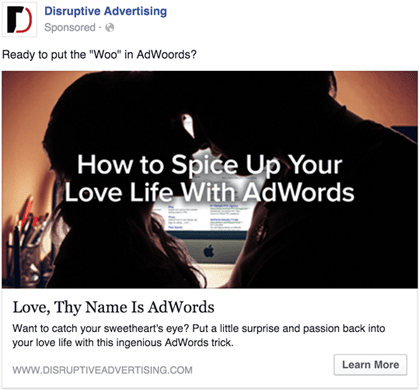Conversion rate optimization (CRO) is a great way to get more out of your online marketing campaigns.
After all, traffic takes a lot of time and expense to generate, so getting more out of your existing traffic is an easy win, right?

Unfortunately, the answer isn’t a simple matter of setting up a test or two and waiting for the conversions to roll in. According to VWO, six out of seven A/B tests fail to produce meaningful conversion rate improvement.
Is it really that difficult to come up with a page variant that drives more conversions? Or are there other factors involved?
To answer that question, you have to look at one of the basic assumptions behind CRO — you are testing relevant, interested traffic.
The rationale behind this assumption is fairly simple. If your traffic is a good fit for your product or offer, they should convert. If they aren’t converting, there must be something about your website or landing page that is hindering the conversion process.
Maybe your call to action doesn’t jive with your audience… maybe your page is missing an important element… maybe your form is too long… or too short…
The list of potential problems goes on and on.

Fortunately, with a little research and a few well-planned tests, you can usually see marked improvements in your conversion rate — by making sure you have the right traffic.
Right ads, wrong clicks
Simply putting together a great ad and reasonable targeting does not guarantee you’ll drive the right traffic to your site.
For example, last year I promoted a blog post on Facebook called “How to Spice Up Your Love Life With Google AdWords.”

The post was a humorous exploration of a unique way to use IP address exclusions in AdWords — an article I expected would be well received by my audience.
I’d run quite a few sponsored posts on Facebook before, so I had a pretty good feel for my target audience (typical CTR, conversion rate, etc.).
Not surprisingly, the sponsored post got a lot of clicks. What was surprising, though, was how few of those clicks filled out my lead gen form — my conversion rate fell through the floor.
At first, I couldn’t figure out what happened. I hadn’t changed my targeting. I hadn’t changed my blog, so the CTA and other page elements were basically consistent. The overall response to the blog post was very positive, so the article seemed to be working for my audience.
So why was my conversion rate so poor?
To figure out what was going on, I took a closer look at my Audience data and discovered something interesting. My CTR was up, but the extra clicks were coming from a very specific demographic: 55+ year-old women.
Apparently, a lot of postmenopausal women were connecting with the “Spice Up Your Love Life” angle.
Now, most Baby Boomers aren’t looking for the services of a digital marketing agency, which explained the low conversion rate.
There wasn’t anything wrong with the blog post — we were simply driving the wrong sort of traffic to our site.
The online marketing focus of our previous sponsored posts had served as a natural filter for the 55+ year-old crowd. This time, however, the idea of improving your love life was even more appealing to the 55+ demographic than it was to our normal demographic!
As a result, we got lots of clicks — but clicks without any real chance of converting.
After changing my targeting to exclude people over 50, my CTR dropped and my conversion rate improved by 57% overnight. Yes, I was driving less traffic to my post, but I wasn’t paying for worthless clicks anymore, either.
AdWords isn’t any better
You’d think things would be better with paid search advertising. After all, you are bidding based on intent, so you should be able to tightly control your traffic.
In theory, yes.
In practice, no.
Over the past two years, we’ve audited over 2,000 AdWords accounts. After looking through thousands of AdWords campaigns, we discovered something surprising:
That alone is a major problem, but it gets worse. As we dug in further, we discovered that the 88% of keywords that aren’t producing conversions account for 61% of ad spend.
Now, one of the big advantages of PPC advertising is the fact that you can limit who sees your ads to the audience of highest intent. However, even in PPC marketing, the average company wastes 61% of their budget on the wrong traffic!
When over half of your traffic has no chance of converting, it should come as no surprise that 86% of A/B tests fail.
You can’t make the wrong traffic convert
“But Jake,” you might ask, “isn’t it all a numbers game? If you get enough traffic to your website, you’ll eventually get some conversions.”
The problem with pushing the wrong type of traffic to a page is the fact that the wrong type of traffic never converts. They simply aren’t interested in what you have to offer and no amount of optimization will make them interested.
For example, back in October 2013, we published an article on our blog called “6 Killer PPC Branding Tactics Even Freddy Krueger Loves!”
It was a halloween-themed content piece that drove a ton of organic traffic to our site. Overnight, we started seeing hundreds of organic visits to the post per day. In fact, the blog post got more hits than our homepage… for over a year.

On the surface, it looked like a runaway content marketing success. The post was ranked on the first page of Google and sent thousands and thousands of visitors to our website.
However, despite all that traffic, we still haven’t seen a single lead from the post.
No one called. No one filled out our form. No one even bothered to open up a chat and say, “Hey, I really enjoyed your article!”
What went wrong?
The post is clearly about pay-per-click advertising, and the search term “ppc” gets 110,000 searches per month. The article was relevant, insightful and talked about points that were relevant to our brand and company.

So, why didn’t anyone convert?
As it turned out, our post was showing up on the first page of Google, but it wasn’t showing up for the search term “ppc.”
It was showing up when people searched “Freddy Krueger.”
I don’t know what all those thousands of searchers thought they were going to get when they clicked “6 Killer PPC Branding Tactics Even Freddy Krueger Loves,” but they definitely weren’t searching for an online advertising agency.
As a result, even with all that traffic, no one ever converted.
Start with your traffic
No amount of CRO will make the wrong traffic convert.
True, you could create a page that anyone would convert on, but even if you create an offer that convinces the wrong traffic to convert, they won’t turn into sales — which is what ultimately matters the most to your business.
So, before you spend weeks running page optimization tests, take a good look at your traffic. Are you setting your tests up to fail?
Consider the following:
- Who is your target audience, really? The more you understand your audience, the more effective your ads will be at bringing the right sort of traffic to your page.
- What’s your target audience’s pain point? Your product or service solves someone’s pain point. As a marketer, your job is to convince your target audience that you can solve their problem, which means your ads should use your target audience’s pain point to filter and prep potential traffic for your website. That way, when they get to your site, they should immediately connect with your solution.
- Do you have great message match? The tighter you can tie your ads and landing page to each other and to your audience’s pain point, the better your traffic quality will be.
- Are you paying for clicks that don’t convert? Dive into your analytics data and see where your money is really going. Stop paying for the wrong traffic.
Improving your traffic will naturally improve your conversion rate. Furthermore, it will also improve the effectiveness of your CRO tests, because you’ll actually be optimizing your page for the right traffic!
Traffic matters
If you want to achieve show-stopping conversion rates, you need an awesome website experience and the right sort of traffic. If you don’t have both, creating a profitable marketing campaign will always be an uphill battle.
You’ve heard my two cents, now I want to hear yours. How have you seen traffic undermine CRO tests?


